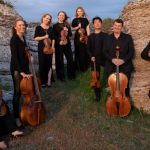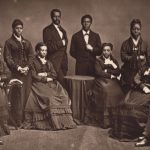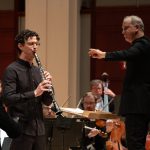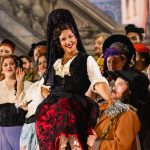September 16, 2023
Glenn Memorial United Methodist Church
Atlanta, GA – USA
Kelly Brzozowski, harp, recorder; Jonathan DeLoach, recorder, organ; Gregory Hamilton, theorbo; Mia Mangano, violone, bass viol, treble viol; Jody Miller, recorder; Erik Schmalz, trombone, recorder; Barbara Weiss, organ, harpsichord, recorder.
Giovanni PICCHI: Pass’e mezzo (c.1619)
Girolamo FRESCOBALDI: Canzon prima à quattro, due canti e due bassi (1634)
Jacques ARCADELT: “O felici occhi miei” (from Il primo libro di madrigali d’Arcadelt à 4 voci, 1539)
Diego ORTIZ: Recercada segunda sobre el madrigal “O felici occhi miei” (from Trattado di Glosas, 1553)
Giovanni Girolamo KAPSBERGER: Toccata 6a (from Intavolatura di chitarone, Libro 1, 1604)
Antonio TROILO: Canzone decimasettima (from Il primo librodelle canzoni, 1606)
Salamone ROSSI: Sonata quarta sopra l’Aria di Ruggiero (from Varie sonate, sinfonie, gagliarde, brandi, e corrente, Libro 3, 1613)
Dario CASTAELLO: (from Sonate concertante in stil moderno, 1621)
Claudio MONTEVERDI: Zefiro tornan e di soavi accenti (from scherzi musicali cioé arie et madrigali, 1632)
Mark Gresham | 25 SEP 2023
The cause of Early Music in North and Middle Georgia got a boost earlier this month with the debut of Sol Divino, a new eight-member ensemble focused on the transitional period between the late Renaissance and the early Baroque. The group presented its debut program, “Between Two Times,” in three Georgia cities: in Oxford on September 14 at the Old Church, in Macon at St. Joseph Catholic Church, and in Atlanta on September 16 at Glenn Memorial United Methodist Church on the campus of Emory University. EarRelevant attended the last of these.
The music performed in this program was all written between 1539 (an instrumental performance of Jacques Arcadelt’s four-voice madrigal, “O felici occi miei”) and 1632 (Claudio Monteverdi’s Zefiro torna e di soavi accenti).
Between those years, Europe witnessed a profound transformation in its cultural landscape. This tumultuous decade-spanning period was marked by significant events and shifts that shaped the continent’s identity and values. The world witnessed a dynamic interplay among European cultural forces: Religious upheavals, scientific advancements, artistic Renaissance, and colonial expansion. All played pivotal roles in shaping the continent’s cultural evolution during this transformative period, laying the groundwork for the Europe we recognize today.
The period began amidst the throes of the Protestant Reformation, triggered by Martin Luther’s 95 Theses in 1517. By 1539, this movement had gained considerable momentum, challenging the authority of the Roman Catholic Church. Notably, in 1539, the first edition of the Calvinist Genevan Psalter was published. In England, Henry VIII’s break with Rome paved the way for establishing the Church of England, signaling a fundamental shift in religious allegiance.
Over the following decades, the religious divide deepened. The Council of Trent (1545-1563) enacted the formal Roman Catholic reply to the challenges of the Protestants, reaffirming traditional doctrines and practices, while the spread of Protestantism led to religious conflicts, most notably the Thirty Years’ War (1618-1648). With its devastating toll on lives and resources, this protracted conflict had a lasting impact on Europe’s religious and cultural fabric.
Amidst this religious turmoil, the Renaissance continued to exert its intellectual influence. Galileo Galilei published his groundbreaking work, “Dialogue Concerning the Two Chief World Systems,” in 1632, which challenged established beliefs and contributed to the growing body of scientific knowledge, setting the stage for the Enlightenment of the 18th century. A growing emphasis on reason, empiricism, and the pursuit of knowledge marked the intellectual climate of the time.
The period from 1539 to 1632 also saw a flourishing of the arts. The Renaissance, characterized by a revival of classical forms and humanistic ideals, reached its zenith in the 16th century. Artists like Leonardo da Vinci, Michelangelo, and Raphael left an indelible mark on European art. Meanwhile, Baroque art, which emerged in the early 17th century, was characterized by its emotional intensity, ornate decoration, and theatricality. Painters like Caravaggio and sculptors like Bernini embodied the Baroque style, reflecting the cultural shifts of the time. English playwright, poet, and actor William Shakespeare (1564 – 1616), arguably the greatest English writer and dramatist, lived in the midst of this transitional time, profoundly influencing English language and literature.
Europe’s expansion into the New World was another defining feature of this period. This era of exploration and colonization brought about a cultural exchange between Europe and the Americas, introducing new foods, ideas, and languages, ultimately shaping European culture in unforeseen ways.
During this period, Europe also witnessed significant changes in instrumental music. Driving these shifts were both revolutionary ideas from the Florentine Camerata (a group of humanists, musicians, poets, and intellectuals in late Renaissance Florence who gathered under the patronage of Count Giovanni de’ Bardi to discuss and guide trends in the arts, especially music and drama) and evolutionary developments already taking place in the artistic mainstream.
Originating in Northern Italy, they spread across Europe and finally reached England. Four key areas of transformation in instrumental music were instrumentation, idiomatic writing, texture, and orchestration, marking a significant transition from the Renaissance to the Baroque era in instrumental music, driven by a desire for greater expressiveness, virtuosity, and emotional impact on listeners. New instruments were coming into use, and new musical forms were developing.
Exploring and performing the music of this remarkable transitional era is the particular mission of Sol Divino.
“Sol Divino came about because Erik Schmalz, Kelly Brzozowski, and I, enjoy late Renaissance and early Baroque repertoire,” says recorder player Jody Miller, one of the three co-founders. “The only performances that happen down in the Southeast, though, are rare one-offs in which either a guest artist is in town, or a Baroque ensemble happens to play a concert with that theme. Amethyst Baroque Ensemble performed such a program in September 2022, but Amethyst is more focused on high Baroque literature and isn’t the right instrumentation for the [late Renaissance/early Baroque] literature. Erik, Kelly, and I were all involved in that performance and are interested in perpetuating the experience.”
Together, they formed what Miller calls a “dream team“ of eight musicians for Sol Divino, seven of whom were available to play these debut concerts. All are professionals experienced in Early Music.
The debut program’s nine selections ranged from solos for harpsichord and chitarrone (theorbo) to recorder consorts and mixed ensemble pieces, all relatively short pieces drawn from collections and performed as purely instrumental works.
Except for the Spanish composer Diego Ortiz and the Franco-Flemish Arcadelt, all the composers represented were either Italian or “hyphenated Italian“ (e.g., the Austrian-Italian Giovanni Kapsberger and the Jewish-Italian Rossi).
Certainly, Northern Italy was the hotbed for creativity during the program’s represented time frame, but the impacts of creative cultural changes went far beyond its region. So, while the program fit well the “Between Two Times” theme and overall mission of Sol Divino (which translates from the Italian as “Divine Sun”), we clearly have a much more extensive range of repertoire to explore in future concerts.
We look forward to how Sol Divino takes on the prospects and possibilities. ■
EXTERNAL LINKS:
- Sol Divino: soldivino.com

Read more by Mark Gresham.
RECENT POSTS
 Tine Thing Helseth brings fire and finesse to trumpet concertos by Arutiunian, Penderecki, and Weinberg • 24 Oct 2025
Tine Thing Helseth brings fire and finesse to trumpet concertos by Arutiunian, Penderecki, and Weinberg • 24 Oct 2025 Camerata Nordica Octet brings Scandinavian color and classical clarity to Hodgson Hall • 21 Oct 2025
Camerata Nordica Octet brings Scandinavian color and classical clarity to Hodgson Hall • 21 Oct 2025




.png)